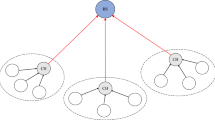Abstract
As the radio spectrum is becoming more and more crowded, cognitive radio has recently become a hot research topic to improve the spectrum utilization efficiency. It is well known that the success of cognitive radio depends heavily on fast and efficient spectrum sensing that is very difficult in practice. Toward this end, this paper introduces a new guard-resident cooperative spectrum sensing scheme for a cognitive ad-hoc network. In particular, we classify cognitive nodes as either resident or guard based on the spectrum neighbor decision and distributed boundary search. The guard nodes sense the spectrum and then inform the resident nodes that are greatly relieved from spectrum sensing about the radio environmental changes. The analysis and simulation results show that the proposed algorithm can significantly reduce the total spectrum sensing load without sacrificing the sensing accuracy.



















Similar content being viewed by others
References
Haykin S (2005) Cognitive radio: brain-empowered wireless communications. IEEE J Sel Area Comm 23(2):201–220
Ghasemi A, Sousa ES (2008) Spectrum sensing in cognitive radio networks: requirements, challenges and design trade-offs. IEEE Comm Manag 46(4):32–39
Cabric D, Mishra SM, Brodersen RW (2004) Implementation issues in spectrum sensing for cognitive radios. Proc 38th Asilomar Conf Signals Syst Compu 1:772–776
Liang YC, Zeng Y, Peh E, Hoang AT (2008) Sensing-throughput tradeoff for cognitive radio networks. IEEE Trans Wireless Comm 7(4):1326–1337
Quan Z, Cui S, Sayed AH (2008) Optimal linear cooperation for spectrum sensing in cognitive radio networks. IEEE J Sel Topics Signal Process 2(1):28–40
Saad W, Han Z, Basar T, Debbah M, Hjørungnes A (2011) Coalition formation games for collaborative spectrum sensing. IEEE Trans Veh Technol 60(1):276–297
Beibei Wang KJ, Liu R, Charles Clancy T (2010) Evolutionary cooperative spectrum sensing game: how to collaborate? IEEE Trans Comm 58(3):890–900
Zhang W, Mallik RK, Letaief KB (2009) Optimization of cooperative spectrum sensing with energy detection in cognitive radio networks. IEEE Trans Wireless Comm 8(12):5761–5766
Krenik W, Batra A (2005) Cognitive radio techniques for wide area networks. Proc., 42nd Conf. Design Automation 409–412
Akyildiz IF et al (2006) NeXt generation/dynamic spectrum access/cognitive radio wireless networks: a survey. Compu Netw 50(13):2127–2159
Krizman KJ, Biedka TE, Rappaport TS (1997) Wireless position location: fundamentals, implementation strategies and sources of error. Proc 47th Conf Veh Technol 2:919–923
Akyildiz IF, Lee W-Y, Chowdhury KR (2009) CRAHNs: cognitive radio ad hoc networks. Ad Hoc Netw 7(5):810–835
Hastie T, Tibshirani R, Friedman J (2009) Elements of statistical learning: data mining, inference and prediction, 14.3.12, Hierarchical clustering. Springer Series in Statistics, pp 520–527
Rui Xu, Wunsch D II (2005) Survey of clustering algorithms. IEEE Trans Neural Netw 16(3):645–678
Yucek T, Arslan H (2009) A survey of spectrum sensing algorithms for cognitive radio applications. IEEE Comm Surveys & Tutorials 11(1):116–130
Haykin S, Thomson DJ, Reed JH (2009) Spectrum sensing for cognitive radio. IEEE Proc 97(5):849–877
Urkowitz H (1967) Energy detection of unknown deterministic signals. IEEE Proc 55(4):523–531
Ma J, Li GY, Juang BH (2009) Signal processing in cognitive radio. IEEE Proc 97(5):805–823
McLurkin J, Demaine ED (2009) A distributed boundary detection algorithm for Multi-Robot systems. IEEE Conf. Intelligent Robots and Syst. (IROS): 4791–4798
Fekete SP, Kaufmann M (2005) A. Kroeller, and N. Lehmann. A new approach for boundary recognition in geometric sensor networks. Proc 17th Can Conf Comp Geom:82–85
A. Kroeller, S. P. Fekete, D. Pfisterer and S. Fischer (2006). Deterministic boundary recognition and topology extraction for large sensor networks. Proc. 7th annual ACM-SIAM symposium on Discrete Algorithm, 1000-1009.
Sahai A, Hoven N, Tandra R (2004) Some fundamental limits on cognitive radio. BWRC Cognitive Radio Workshop:1662–1671
Acknowledgments
This work was supported in part by the US National Science Foundation (#1032567), the University of Louisville Research Initiation Grant. The work of Weiyao Lin was supported by the National Natural Science Foundation of China (#61001146). The work of Xudong Wang was supported by the National Natural Science Foundation of China (No. 61172066), Shanghai Pujiang Scholar Program (10PJ1406100), and the MOE Program for New Century Excellent Talents.
Author information
Authors and Affiliations
Corresponding author
Rights and permissions
About this article
Cite this article
Du, Y., Li, H., Lin, W. et al. A New Cooperative Spectrum Sensing Scheme for Cognitive Ad-Hoc Networks. Mobile Netw Appl 17, 746–757 (2012). https://doi.org/10.1007/s11036-012-0387-x
Published:
Issue Date:
DOI: https://doi.org/10.1007/s11036-012-0387-x




